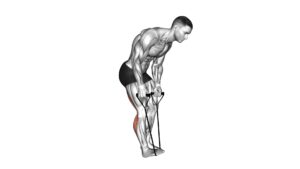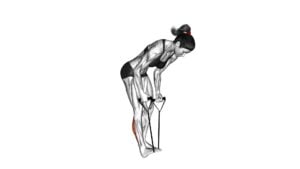Standing Gastrocnemius Calf Stretch – Video Exercise Guide & Tips

Are you looking for an effective way to stretch your calf muscles? Look no further than the Standing Gastrocnemius Calf Stretch!
Watch This Exercise Video
This exercise targets your calves and can help improve flexibility and prevent injuries.
In this article, we will guide you through the proper form and technique, offer variations for different fitness levels, and share common mistakes to avoid.
Plus, we'll provide tips on how to incorporate this stretch into your fitness routine.
Let's get started!
Key Takeaways
- Improved flexibility and range of motion
- Reduced risk of muscle strains or tears
- Enhanced athletic performance
- Promotes relaxation and stress relief
Benefits of the Standing Gastrocnemius Calf Stretch
What are the benefits of performing the Standing Gastrocnemius Calf Stretch?
This exercise offers numerous advantages, including improved flexibility and injury prevention. By incorporating this stretch into your routine, you can enhance the flexibility of your calf muscles, which can be beneficial for athletes, dancers, or individuals involved in activities that require quick and powerful movements.
The Standing Gastrocnemius Calf Stretch specifically targets the gastrocnemius muscle, the larger of the two calf muscles. This stretch involves standing with one foot in front of the other, keeping the back leg straight, and leaning forward until a gentle stretch is felt in the calf.
By regularly performing this stretch, you can increase the range of motion in your calf muscles, allowing for greater flexibility and reduced risk of muscle strains or tears.
Additionally, the Standing Gastrocnemius Calf Stretch can help prevent injuries by improving the overall flexibility and mobility of the lower leg. Incorporating this stretch into your warm-up routine before physical activity can prepare your calves for the demands of exercise and decrease the likelihood of injury.
Proper Form and Technique for the Stretch
To perform the Standing Gastrocnemius Calf Stretch properly, follow these steps:
- Stand with one foot in front of the other.
- Keep your back straight and engage your core.
- Place your hands on a wall or sturdy object for support.
- The foot in front should be facing forward, while the back foot should be slightly turned outward.
- Shift your weight onto the front foot.
- Slowly bend your front knee.
- Keep the back leg straight and press the heel into the ground.
- You should feel a stretch in the calf muscle of the back leg.
- Hold this position for about 30 seconds, then switch sides.
Proper form and technique are essential for improving flexibility and preventing injuries during the Standing Gastrocnemius Calf Stretch.
- Avoid bouncing or jerking movements, as this can strain the muscles and increase the risk of injury.
- Focus on maintaining a steady and controlled stretch.
Remember to breathe deeply throughout the stretch, as deep breathing helps to relax the muscles and enhance the effectiveness of the stretch.
- Listen to your body and avoid pushing yourself too far.
- If you experience any pain or discomfort, ease off the stretch immediately.
Variations and Modifications for Different Fitness Levels
As you progress in your fitness journey, you can modify the Standing Gastrocnemius Calf Stretch to accommodate different levels of flexibility and strength. Here are some variations and modifications for individuals with different fitness levels:
- Advanced modifications for the standing gastrocnemius calf stretch:
- Single-leg variation: Instead of performing the stretch with both legs, try doing it with one leg at a time. This will increase the intensity and challenge your balance.
- Elevated surface: Place the ball of your foot on a step or a raised platform while performing the stretch. This will provide a deeper stretch to your calf muscles.
- Modifications for individuals with limited flexibility for the standing gastrocnemius calf stretch:
- Bent knee variation: If you find it difficult to keep your legs straight during the stretch, you can slightly bend your knees. This will reduce the tension in your calf muscles and make it more comfortable.
- Wall support: Stand facing a wall and place your hands on it for support. This will help you maintain balance and stability while performing the stretch.
Remember to listen to your body and only go as far as you feel comfortable. With time and consistency, you'll gradually improve your flexibility and strength.
Common Mistakes to Avoid During the Stretch
To ensure proper execution of the Standing Gastrocnemius Calf Stretch and maximize its benefits, it's important to be aware of common mistakes to avoid during the stretch. By avoiding these mistakes, you can prevent injury and ensure that you're targeting the correct muscles effectively.
One common mistake isn't maintaining proper posture throughout the stretch. It's important to stand tall with your shoulders back and your core engaged. Avoid rounding your back or slouching forward, as this can reduce the effectiveness of the stretch and put unnecessary strain on your spine.
Another mistake to avoid isn't fully extending your leg during the stretch. Make sure to fully straighten your leg and keep your foot flexed. This will allow for a deeper stretch in the calf muscles.
Additionally, rushing through the stretch is a common mistake. Take your time and hold the stretch for at least 30 seconds on each leg. This will give your muscles enough time to lengthen and relax.
Incorporating proper technique into your calf stretch routine is essential for maximizing its benefits and preventing injury. By being aware of these common mistakes and avoiding them, you can ensure that you're getting the most out of this exercise.
Now let's move on to some tips for incorporating the stretch into your fitness routine.
Tips for Incorporating the Stretch Into Your Fitness Routine
To effectively incorporate the Standing Gastrocnemius Calf Stretch into your fitness routine, consistently perform it at least three times a week. This will ensure that you're giving your calf muscles the necessary attention they need for flexibility improvement.
Here are some tips to help you seamlessly integrate this stretch into your routine:
- Schedule it: Set a specific time in your weekly schedule dedicated solely to stretching exercises. By making it a regular part of your routine, you're more likely to stick to it and see results.
- Warm up: Before performing the Standing Gastrocnemius Calf Stretch, make sure to warm up your muscles with some light cardio exercises. This will help prepare your calves for the stretch and prevent any potential injuries.
- Progress gradually: Start with a comfortable stretch and gradually increase the intensity over time. Push yourself gently but avoid overstretching, as it can lead to muscle strain or injury.
Frequently Asked Questions
How Long Should I Hold the Stretch for Maximum Benefit?
For maximum benefit, it's important to hold the stretch for the optimal stretch time. This ensures that your muscles have enough time to lengthen and improve flexibility.
The duration of the stretch will vary depending on factors such as your fitness level and individual needs. It's generally recommended to hold the standing gastrocnemius calf stretch for about 30 seconds to 1 minute.
Remember to listen to your body and adjust the duration accordingly.
Can the Standing Gastrocnemius Calf Stretch Help With Foot and Ankle Pain?
The standing gastrocnemius calf stretch can be effective in relieving foot and ankle pain. By stretching the calf muscles, it helps to improve flexibility and reduce tension, which can alleviate pain in the foot and ankle.
The benefits of this stretch include increased range of motion, improved circulation, and enhanced overall muscle function.
Incorporating the standing gastrocnemius calf stretch into your routine can be a valuable addition to your efforts in managing foot and ankle discomfort.
Is It Normal to Feel Discomfort or a Pulling Sensation During the Stretch?
Feeling discomfort or a pulling sensation during the stretch is normal. This is because the standing gastrocnemius calf stretch targets the calf muscles, which can be tight or contracted.
As you stretch, you may experience a sensation of tension or pulling in the calf area. However, it's important to listen to your body and not push yourself too hard.
Start with a shorter stretching duration and gradually increase it as your muscles become more flexible.
Can I Do the Stretch if I Have a Previous Calf Injury?
If you have a previous calf injury, it's important to consult with a healthcare professional before attempting the Standing Gastrocnemius Calf Stretch. They can provide guidance on whether it's safe for you to do this stretch and may recommend specific rehabilitation options.
If the stretch isn't suitable for you, they can suggest alternative stretches that can help with calf flexibility and strengthening. It's always best to prioritize your safety and follow professional advice in these situations.
Are There Any Specific Warm-Up Exercises I Should Do Before Performing the Standing Gastrocnemius Calf Stretch?
Before performing the standing gastrocnemius calf stretch, it's important to do specific warm-up exercises to prepare your muscles for stretching. Incorporate warm-up exercises like ankle circles, calf raises, and gentle calf stretches to increase blood flow and flexibility in the calf muscles.
These warm-up exercises will help prevent injury and enhance the effectiveness of the standing gastrocnemius calf stretch. Remember to always listen to your body and stop if you experience any pain or discomfort.
Conclusion
Incorporating the standing gastrocnemius calf stretch into your fitness routine can provide numerous benefits. This stretch is especially effective at improving flexibility and preventing injuries. By maintaining proper form and technique, you can effectively stretch your calf muscles and target the gastrocnemius. Remember to avoid common mistakes, such as bouncing or overstretching, and adapt the stretch to your fitness level. With these tips in mind, you can optimize your calf stretching routine and enhance your overall fitness journey.

Author
Years ago, the spark of my life’s passion ignited in my mind the moment I stepped into the local gym for the first time. The inaugural bead of perspiration, the initial endeavor, the very first surge of endorphins, and a sense of pride that washed over me post-workout marked the beginning of my deep-seated interest in strength sports, fitness, and sports nutrition. This very curiosity blossomed rapidly into a profound fascination, propelling me to earn a Master’s degree in Physical Education from the Academy of Physical Education in Krakow, followed by a Sports Manager diploma from the Jagiellonian University. My journey of growth led me to gain more specialized qualifications, such as being a certified personal trainer with a focus on sports dietetics, a lifeguard, and an instructor for wellness and corrective gymnastics. Theoretical knowledge paired seamlessly with practical experience, reinforcing my belief that the transformation of individuals under my guidance was also a reflection of my personal growth. This belief holds true even today. Each day, I strive to push the boundaries and explore new realms. These realms gently elevate me to greater heights. The unique combination of passion for my field and the continuous quest for growth fuels my drive to break new ground.







